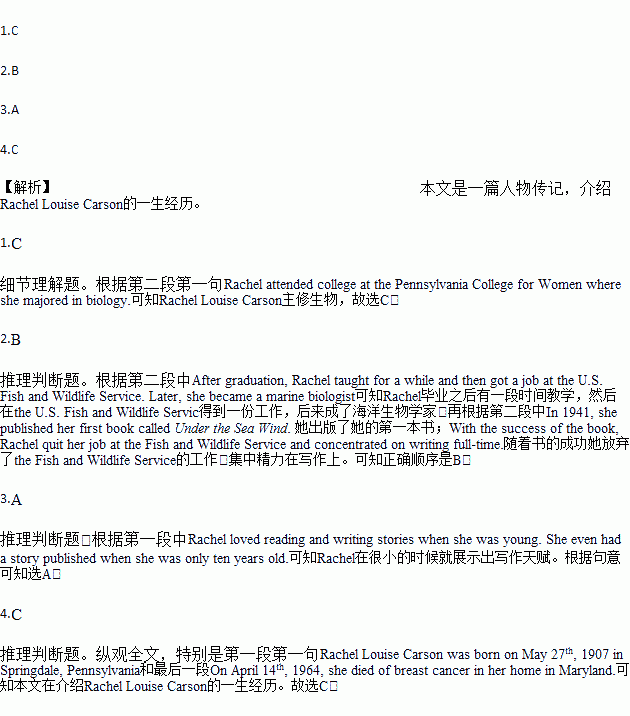题目内容
Rachel Louise Carson was born on May 27th, 1907 in Springdale, Pennsylvania. She grew up on a farm where she learnt about nature and animals. Rachel loved reading and writing stories when she was young. She even had a story published when she was only ten years old. One of Rachel’s favorite subjects was oceanology(海洋生物学).
Rachel attended college at the Pennsylvania College for Women where she majored in biology. She later got her master’s(硕士) degree in zoology from John’s Hopkins University. After graduation, Rachel taught for a while and then got a job at the U.S. Fish and Wildlife Service. At first, she wrote for a weekly radio program that educated people on marine(海洋的) biology. Later, she became a marine biologist and chief editor of publications for the Fish and Wildlife Service. In addition to her work at the Fish and Wildlife Service, Rachel wrote articles for magazines about the ocean. In 1941, she published her first book called Under the Sea Wind. However, her second book, The Sea Around Us, made her famous. The Sea Around Us was published in 1951 and was on the New York Times bestseller list for 39 weeks. With the success of the book, Rachel quit her job at the Fish and Wildlife Service and concentrated on writing full-time.
After Worl d WarⅡ, farmers began to use pesticides (农药) such as DDT on their crops. Rachel was concerned about the effects that large-scale spraying of DDT may have on the health of people as well as the environment. Rachel began to gather research material on pesticides and write a book about the subject.
d WarⅡ, farmers began to use pesticides (农药) such as DDT on their crops. Rachel was concerned about the effects that large-scale spraying of DDT may have on the health of people as well as the environment. Rachel began to gather research material on pesticides and write a book about the subject.
Rachel spent four years gathering research material and writing the book. She named it Silent Spring referring to bird death due to pesticides and the spring being silent without their songs. Published in 1962, the book became very popular and brought the environmental issues of pesticides to the general public.
On April 14th, 1964, she died of breast cancer in her home in Maryland.
1.What did Rachel Louise Carson major in for her bachelor’s(学士) degree?
A. Oceanology. B. Zoology.
C. Biology. D. Engineering.
2.What is the right order of the following events about Rachel’s life?
a. She collected material for Silent Spring.
b. She taught for a while after graduation.
c. She gave up her job at the Service.
d. She had her first book published.
She had her first book published.
e. She became a marine biologist.
A. d-a-c-b-e B. b-e-d-c-a
C. d-c-a-b-e D. b-d-c-e-a
3.It can be inferred from the passage that _______.
A. Rachel showed a talent for writing at a young age
B. it took little effort for Rachel to write Silent Spring
C. it was Silent Spring that brought Rachel instant fame
D. Rachel is believed to be more a biologist than a writer
4.What type of writing is the article likely to be?
A. A short story. B. A book review.
C. A biography. D. A news report.
 小学教材全测系列答案
小学教材全测系列答案 小学数学口算题卡脱口而出系列答案
小学数学口算题卡脱口而出系列答案 优秀生应用题卡口算天天练系列答案
优秀生应用题卡口算天天练系列答案 浙江之星课时优化作业系列答案
浙江之星课时优化作业系列答案

 t always easy.
t always easy. , they often reach excellent academic results.
, they often reach excellent academic results.